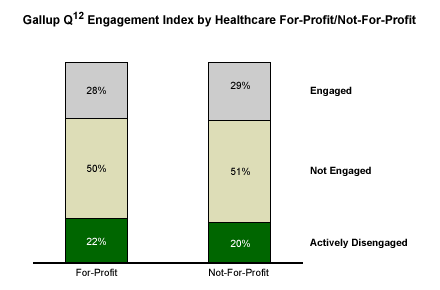In their ongoing search to find differences between for-profit and not-for profit hospitals, healthcare observers continually seek evidence to support the assumption that there is an inherent conflict between the mission of healing and the mission of making a profit. However, Gallup patient satisfaction scores of for-profit and not-for-profit hospitals indicate that, at least in the eyes of the patients, the conflict does not exist (see "Are For-Profit Hospitals Different?" in Related Items). But what about the perspective of hospital employees -- is there a difference in employee engagement levels among those doing the healing?

Gallup measures employee engagement using 12 core Gallup workplace management questions. Gallup research on employee engagement has shown direct linkages to patient loyalty, financial performance, malpractice experience, staff productivity and turnover. Employees are categorized into three engagement types:
- Engaged employees are loyal and psychologically committed to the organization. These employees have most of their performance-related workplace needs met.
- Employees who are not engaged may be productive, but are not psychologically connected to the organization. They have some of their performance-related workplace needs met, but many go unmet.
- Actively disengaged employees are physically present but psychologically absent. Most of their performance-related workplace needs are unmet.
Twenty-eight percent of for-profit hospital employees are engaged, compared to 29% of not-for-profit hospital employees. At the other extreme, 22% of for-profit employees and 20% of not-for-profit employees are actively disengaged. These data indicate that there is no real difference in the ability of for-profit and not-for-profit hospitals to meet the performance-related workplace needs of their staff.
Why No Difference?
Given the finding that patient satisfaction scores do not vary between for-profit and not-for-profit hospitals, it comes as no great surprise that there is also no difference in employee engagement scores, because employee engagement is the strongest single predictor of patient satisfaction. In other words, strong differences in employee engagement scores would tend to translate into variances in patient satisfaction.
But that begs the question -- is it surprising that the different orientations of for-profit and not-for-profit hospitals don't seem to have an effect on employee engagement levels? Healthcare workers, relative to workers in other industries, place a higher emphasis on the mission of the organization. If the missions of not-for profit hospitals tended to be different or better articulated than the missions of for-profit hospitals, one would expect a difference in employee engagement scores. But the fact is that all healthcare organizations -- both for-profit and not-for-profit -- must recognize that positive financial performance is essential to perpetuating the healing mission. Mission differences are thus blurred between these two types of organizations.